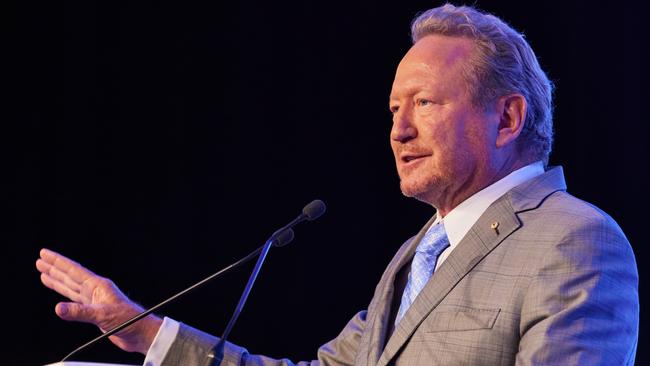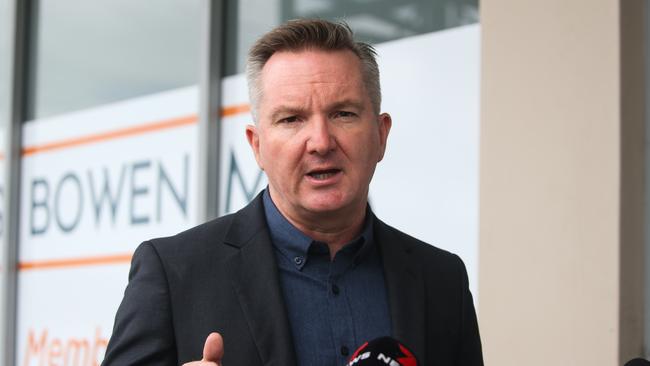Andrew Forrest pledges massive renewable expansion by 2030
Billionaire Andrew Forrest, through Squadron Energy, has promised 14GW of renewable energy by 2030 in a move which has Canberra breathing easier about meeting its targets.
Squadron Energy, Australia’s largest renewable energy developer – owned by billionaire Andrew Forrest – has promised to deliver more than a third of the solar and wind generation capacity that the country must build by 2030 in a major boost to the country’s ailing energy transition.
Squadron Energy had pledged to build 20GW of new solar and wind generation, but Mr Forrest on Thursday said the overwhelming majority of the new build will occur by 2030 with 14GW of new capacity added.
The target, should it be met, would mark a substantial increase to Australia’s renewable energy capacity and mark a pivotal moment in Australia’s energy transition. The Australian Energy Market Operator estimates the country needs 57GW of grid-scale solar and wind generation capacity to be installed by 2030 – a rise from the current capacity of 19GW.
Australia – one of the world’s largest per capita emitters – is currently on course to miss its renewable energy targets to wean of coal – which has stoked concerns the country will have to either prolong the use of coal or risk blackouts.

Mr Forrest said the accelerated targets underscore the need to progress the transition.
“The time for talk is over, we are investing in Australia’s green energy transition and creating jobs and economic development for regional Australia,” Mr Forrest said.
“No longer will we have to rely on expensive, volatile, planet destroying fuels. We will have secure and inexpensive energy from a huge new industry for Australia.”
Squadron Energy has less than 2GW of wind and solar capacity operating or under construction, and to meet its target it will require a seven fold increase in just six years.
Mr Forrest acknowledged to The Australian that the timetable is aggressive and ambitious, but said the country must “swing big”.
“If we really commit to something, we will get it done. Yes, it is tight, it is tough but that is why we are having a crack at it,” Mr Forrest told The Australian.
Should Squadron fulfil its lofty goal, it would cement itself as Australia’s largest renewable energy developer, well ahead of traditional energy giants such as AGL Energy and Origin Energy.
To meet its ambitious and aggressive timetable, Squadron said it has entered into a $2.75bn deal with turbine manufacturer GE Vernova, which Squadron Energy chief executive Jason Willoughby said will drastically reduce supply chain risk.
The Australian understands that GE Vernova will supply the turbines for three wind farms, including the Uungula Wind Farm near Wellington in central west NSW which Squadron begun construction on Thursday. An announcement over two new wind farms, which are likely to include solar and batteries, is expected imminently.
“With a growing demand on the manufacture of turbines globally, by entering into this alliance, Squadron Energy is planning for its production slots for the next 1GW of turbine supply, significantly reducing the risk on the supply chain for upcoming projects,” said Mr Willoughby.
The target is a boost to the federal Labor government, which has pledged to meet its target of having renewable energy generate 82 per cent of the country’s power by 2030, which it said will allow the country to meet legislated targets to reduce carbon emissions by 43 per cent.
Federal Energy minister Chris Bowen hailed the actions of Squadron Energy, claiming the move as evidence of corporate Australia responding to Labor’s energy policy assurance.
“These projects are further proof renewable energy investors are getting on with the job, capitalising on Australia’s huge renewable potential, and helping transform our energy grid for the 21st century,” Mr Bowen said.

Australia is facing mounting pressure to accelerate its energy transition, with the Australian Energy Market Operator warning that it now expects all coal power stations to be shuttered inside the next 15 years.
Several major coal power stations in NSW and Victoria are expected to be mothballed in less than a decade, heightening the need for a substantial increase in new capacity.
But new zero emission projects continue to struggle to materialise, with developments slowed by delays to much needed transmission lines to carry the electricity produced and regulatory logjams.
Australia’s energy transition was dealt a blow late last year when the near $20bn acquisition of Origin by Canadian private equity giant Brookfield and EIG Partners fell at the last hurdle. Brookfield had promised to spend $20-$30bn on 14GW of new renewable energy.
To break the impasse, Labor last year promised to underwrite a massive expansion of 32GW of new wind, solar and battery projects and Squadron’s ambition would go a long way to meeting the goal of the government.
The so-called capacity investment scheme government scheme sees developers guaranteed a minimum return on new solar and wind projects. Under the scheme, should the wholesale electricity price fall below an agreed threshold – taxpayers will compensate the renewable energy project. Should the wholesale electricity price exceed a metric, developers pay the government – a design that removes revenue risk from developers and accelerates much-needed investment.
The government also said it would streamline planning approvals for new solar and wind projects, which can often take years to secure final approvals.
Still, there remains fierce debate about the future of Australia’s energy system. The opposition Coalition has proposed the country adopt nuclear – a proposal swiftly rejected by Mr Forrest.
“I don’t know how [young voters] would react to a nuclear reactor, but they probably won’t like that costs will go up three or four times. If you want fossil fuels, that is okay too, but you will be paying around double,” Mr Forrest told The Australian.
Labor insists nuclear would be prohibitively expensive and would not be ready to replace coal – still the dominant source of Australia’s electricity – when all plants are closed.
Nuclear energy supporters insist the industry would avoid the need for new transmission lines and the industry could create jobs that would otherwise be lost by the demise of coal.
Transmission delays, however, remain a potential hindrance — and energy executives said the issue would be critical if Mr Forrest is to meet its target.
Many local communities vowing to oppose the high voltage transmission lines despite increasingly lucrative compensation packages.
Mr Bowen said the government was sensitive to local communities and their feelings around transmission and routes have been altered as a result – but the infrastructure was vital.
Around 10,000km of new high-voltage transmission lines must be built before 2050.





To join the conversation, please log in. Don't have an account? Register
Join the conversation, you are commenting as Logout